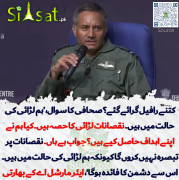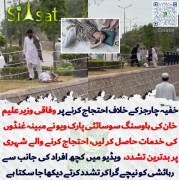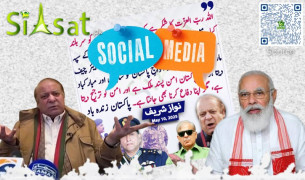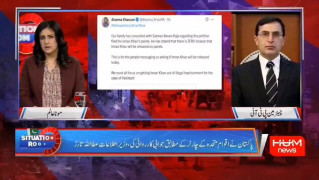Geek
Chief Minister (5k+ posts)

Her works are part of the permanent collections of some of the worlds most famous museumsthe Museum of Modern Art, the Whitney, the Guggenheim. In 2005, The New York Times called her an an artist on the verge of shaking things up. The year before that, Newsweek counted her among the clutch of overachieving South Asians transforming Americas cultural landscape. Shahzia Sikander, arguably Pakistans most famous living modern artist, has been wowing the international art world with her multidisciplinary works inspired from Mughal-era miniature painting techniques and tropes. Shes been scoring accolades since graduating from the Rhode Island School of Design in 1995. Last year, the U.S. secretary of State awarded her the Inaugural Medal of Art. Shes previously won a MacArthur Genius Grant. While Pakistan hasnt entirely ignored Sikandershe won the Presidents National Pride of Honor award in 2005shes hardly a household name in her home country, and viewed by Pakistani critics as an outlier. We spoke with Sikander recently about her art and life. Excerpts:
From the National College of Arts in Lahore to the pinnacle of the global art scene, whats the journey been like for you?
Complex, the way life is. Its hard to summarize more than two decades in a single answerbesides, the journey is still unfolding. In retrospect I would have, perhaps, made some different decisions, but Im appreciative of all the opportunities and detours I experienced that helped me develop my ability to think and express.
Youve rarely held any shows in Pakistan, why?
Not being invited in any serious manner to exhibit works in Pakistan is an issue. Compounding the situation is also the fact that almost all of my work got collected rapidly by international museums in the late 1990s and early 2000s. To show the work, it has to be loaned directly from the [collecting] institutions. It was never as simple as putting the work in a suitcase to be brought over to Pakistan to exhibit.
Do you think your work has helped change how women artists from the Muslim world are viewed abroad, judged on the basis of the work rather than the baggage of biography?
Our actions speak for ourselves. If anything my choices in life do not fit into any stereotypes. I am a strong advocate for womens education. The support I received from my family and mentors in Pakistan was instrumental in allowing me to think for myself, take responsibility for my actions, and develop a healthy sense of independence and self-worth. Unfortunately, stereotypes get resurrected often around the world for all sorts of people. Muslim women are subjected to this much more frequently. Over the years there have been numerous opportunities to debunk or challenge these stereotypes, and I have been there many times through my work and through my life.
How much of your work is informed by your heritage, your Pakistani identity?
My identity is very much about my being from the subcontinent. It is not as if I left my roots and have to find ways to engage with them. I came of age in Pakistan. My engagement with Indo-Persian miniature painting started in the mid to late-80s when I was studying at the NCA. My interest in miniature painting was primarily to explore its context to address contemporary practices. It was more of a conceptual activity from the beginning, but I also embraced its craft and technique and illustrative sensibilities. At the time there was no serious interest at the NCA in critically engaging with miniature painting. I wanted to understand the social construct of a so-called traditional genre in a contemporary society. It was exciting to examine, imagine, and explore the many possibilities of a traditional genre whose future had not yet been laid out in any clear terms. Miniature painting still remains a space to unleash my imagination, a genre heroic in scope and not limited by its scale. Even my most recent work, a multichannel film, is technically made from hundreds of small, detailed drawings and paintings. The outcome might not be a typical miniature painting, but the process is uncannily similar.
Is there meaning behind the repetition of certain symbols and shapes across your work?
Im interested in the idea of transformation and often cull forms and motifs from historical sources as well as pop culture to cultivate new associations. In some instances the same imagery gains a different meaning by virtue of being presented in a new context or format. For example, from 1993 to 1995, I experimented by isolating forms from within small miniature paintings and painting them large, often at the scale of 100-feet-plus. The shift in scale was an attempt to test the abilities of the forms to expand in their meaning and become confrontational. It was also an attempt to move out of the preciousness of the small, detailed miniature paintings toward more ephemeral wall and floor drawings. I get drawn toward cultural and political boundaries as a space to examine and to locate ideas for my work. In some instances the language is metaphoric and in some situations it is a sum of various aesthetics and mediums. My most recent work brings together all sorts of disciplinespoetry, painting, calligraphy, vocalists, sopranos, composing, choreography, and performanceinto one piece.
You have two degrees in painting, but your work has increasingly incorporated elements from other disciplines, including film. Which medium do you most connect with?
Im interested in flux, perhaps as a response to having my work often be straight-jacketed in terms of my biography or nationality. Its not unusual to move back and forth between different modes of expression. Working across multiple genres allows more dialogue to emerge and opens up a range of perspectives. In the end it does not matter if I use painting or video to address a topic. Whatever makes the overall work more compelling is usually the direction I take. Another way to examine a shift in mediums is by observing the transformation of a traditional topic like portraiture; it can gain as well as lose meaning depending on what form it is represented in. Im interested in that moment of transformation when, say, portraiture becomes caricature or when satire loses its humor. Another fundamental difference between painting and animation is that given how fast technology is changing and becoming accessible, mobility becomes paramount: video can reach a much larger audience and be exhibited simultaneously in multiple venues.
Do you feel your work would have progressed to the same point had you continued to live in Pakistan?
The experimentation is more an outcome of growth rather than access to technology. It is difficult to know what direction my work would have taken under a different set of situations. My curiosity about different mediums and methods is linked to the process of how I conceive an idea and its outcome. The creative process is often complicated, an outcome of imagination, knowledge, and risk taking.
What has been the most encouraging or disappointing response to your work?
One of the most memorable experiences was the introductory reception to my work by the New York art world in 1997. At that time I was living in Houston, Texas, but got the opportunity to show my work simultaneously at the Drawing Center and the Whitney. Both shows were received exceptionally well and were reviewed by two of the most important art critics, Michael Kimmelman and Roberta Smith. However, there has also been some work thats better hidden under the bed.Source



























